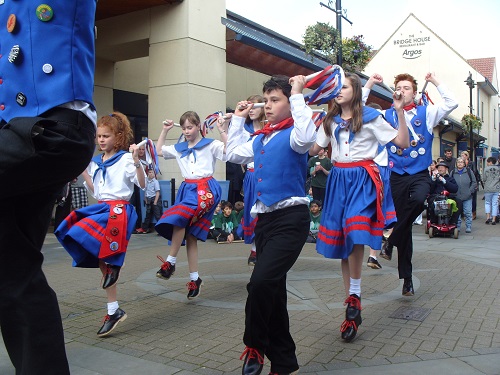


These dances were traditionally performed in the nineteenth and early twentieth century, often in connection with procession at May or June carnivals or Rushbearing ceremonies. Some dances were linked to the Guilds, and some were devised for competitions. There are records of teams of morris dancers in the North-West part of the Country which go back to the C17th but little is known about what they danced. Research into how these dances were performed does not go back much before the mid C19th when records of men's, women's, and mixed teams can be found.
The recent revival has spread these dances around the country, where they are danced by adults or young people in morris teams in a variety of styles. The dances are usually known by the name of their place of origin, although, over the years teams have written their dances in the style of the original north west morris dances. Young Miscellany have written some dances, and have interpreted others based on collected notations.
Within North West Morris are dances with a variety of characteristics. These include dances in which the members of the team hold garlands, short or long sticks (usually decorated with bells and ribbons), slings often plaits of rope), or shillelaghs/shakers. The steps used in the dances are a further defining characteristic, and may be be indicative of the ability or age of the original dancers or teachers. It is also true to say that more rural areas, eg Cheshire have produced more skipped or double stepped dances, whereas the more urban areas have produced a greater number of marching, ranted, or polka stepped dances. This may be related to the type of footwear (clogs) usually worn in the industrial areas.
Some early dancers would have worn clogs (everyday footwear) to dance in. The shods were likely to have been iron that would have made a good noise as well as spark on the cobbled streets. Clogs were replaced with plimsoles in competitive dancing. Today we wear character shoes, or clogs with rubber shods (less slippery and not so destrictive to floors) depending on the style of the dance.
The costume worn by Y.M. is designed to be eye catching and attractive, whilst being comfortable to wear during these energetic dances. It was designed especially by their young members. Teams are often identified by their costumes, and competition to look good as a team is as relevant today as it was in the competitions in the C20th.
Bells and badges decorate costumes to provide an additional attraction as they would have done in times gone by. These would have drawn the attention of crowds watching a procession, and hopefully generated a small sum of money for the team.
Website created by Roger Swaine